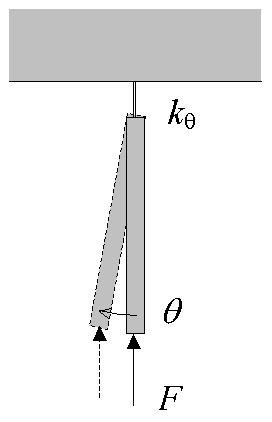 | ||
Elastic instability is a form of instability occurring in elastic systems, such as buckling of beams and plates subject to large compressive loads.
Contents
Single degree of freedom-systems
Consider as a simple example a rigid beam of length L, hinged in one end and free in the other, and having an angular spring attached to the hinged end. The beam is loaded in the free end by a force F acting in the compressive axial direction of the beam, see the figure to the right.
Moment equilibrium condition
Assuming a clockwise angular deflection
where
which has three solutions, the trivial
which is imaginary (i.e. not physical) for
Energy method
The same result can be obtained by considering energy relations. The energy stored in the angular spring is
and the work done by the force is simply the force multiplied by the vertical displacement of the beam end, which is
The energy equilibrium condition
Stability of the solutions
Any solution
An infinitesimal clockwise change of the deformation angle
which can be rewritten as
since
The solution
for
Multiple degrees of freedom-systems
By attaching another rigid beam to the original system by means of an angular spring a two degrees of freedom-system is obtained. Assume for simplicity that the beam lengths and angular springs are equal. The equilibrium conditions become
where
The non-trivial solutions to the system is obtained by finding the roots of the determinant of the system matrix, i.e. for
Thus, for the two degrees of freedom-system there are two critical values for the applied force F. These correspond to two different modes of deformation which can be computed from the nullspace of the system matrix. Dividing the equations by
For the lower critical force the ratio is positive and the two beams deflect in the same direction while for the higher force they form a "banana" shape. These two states of deformation represent the buckling mode shapes of the system.
